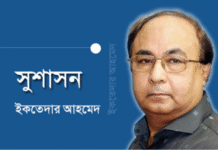Cancer treatment in Bangladesh: Still a long way to go

According to the World Health Organization, cancer is the second leading cause of death globally and a staggering 9.6 million people died of cancer just in 2018. To raise awareness of this fatal disease, and encourage its prevention, diagnosis and treatment, the world today is observing “World Cancer Day” with a range of activities. Different types of organisations and hospitals are also observing this day in Bangladesh with conferences, seminars and a range of awareness-raising campaigns. However, these activities probably carry little meaning for the thousands of Bangladeshi cancer patients and their family members who have suffered financially, physically, and mentally while continuing the treatment in Bangladesh.
The overwhelming treatment cost, wrong diagnosis, faulty treatment plan and shortage of trained doctors and treatment facilities have severely reduced Bangladesh’s capacity to ensure proper treatment for its growing cancer patients. According to the 2018 report by the International Agency for Research on Cancer, every year an estimated 1.5 lakh people develop cancer in Bangladesh. However, there is only one functioning palliative care under government management at Bangabandhu Sheikh Mujib Medical University (BSMMU). There are only four specialised cancer hospitals in the country. Outside Dhaka, there is only one functional radiotherapy facility, at Chittagong Medical College Hospital, in operation for around three months now.
Actually, we don’t even know the exact number of people suffering from cancer in the country as we don’t have any population-based data on the prevalence of cancer. How many patients contract cancer each year? How many patients die of cancer every year? What are the most frequent cancers among Bangladeshis? How many people cannot access treatment? The NICRH, Bangladesh’s apex cancer institute, or any of the country’s medical institutes have no answers to these questions.
Due to absence of data, the International Agency for Research on Cancer published its report on Bangladesh’s cancer scenario based on cancer registry data available in the neighbouring countries. Bangladesh also does not have a national protocol for treating cancer patients.
Currently, Bangladeshi patients are treated according to the cancer protocol for US citizens called Evidence-Based Cancer Guidelines, developed by the US’s National Comprehensive Cancer Network (NCCN) for their own citizens, whereas countries like India and Singapore have developed their own national protocol for cancer treatment as cancer patients require highly individualised treatment. Unfortunately, the NICRH, which has not even published a single research journal in its 36 years of existence, is way behind in developing a national protocol for cancer treatment.
Without knowing the most common cancer(s) among Bangladeshis, without having any national protocol, without knowing the age-standardised incident rate, without having any population-based cancer registry, how the NICRH and other hospitals prepare for treating cancer patients remains a mystery.
In fact, due to the absence of a national protocol and any comprehensive treatment approach, most of the cancer patients in Bangladesh are treated by an individual specialist who rarely consults with other specialists regarding the treatment plan and physical condition of the patients. However, for treating cancer patients, forming a “tumour board”—which is a medical board consisting of a surgical, medical and radiation oncologist, an onco-pathologist and several other specialists depending on the patient’s medical condition—is a standard convention practiced all over the world. However, this concept is virtually unknown in Bangladeshi hospitals that have been treating thousands of cancer patients every year.
The severe shortage of efficient manpower in specialised cancer treatment also contributes to this deteriorating situation. The number of trained gynae-oncologists in Bangladesh is no more than 10, whereas it has been estimated that around 6,582 women die of cervical cancer here each year. Even in many medical institutions, oncology units and departments are often run by doctors who do not have any oncology background. For instance, there are departments on paediatric haematology and oncology in eight medical colleges of Bangladesh but most of these are run by paediatricians, many of whom do not have academic degrees in oncology. The reason? The number of paediatric oncologists in Bangladesh is only about 18-20 and most of them are based in Dhaka.
There is no onco-pathologist in our country specialised in cancer diagnosis. Bangladeshi hospitals and diagnostic centres still have to depend solely on microscope and regular pathologists to detect a cancerous tumour. The immune-histochemistry test, which can diagnose cancer more precisely, is also not available in Bangladesh.
On the other hand, when the world is advancing towards more localised and efficient treatment methods such as immunotherapy, hormone therapy and proton therapy for cancer patients, for those in Bangladesh, painstaking and highly expensive chemotherapy and radiation therapy are the only options. Such conventional diagnostic procedures and treatment plans developed by an individual specialist make Bangladeshi cancer patients highly vulnerable to wrong diagnosis and faulty treatment plan.
Again, Bangladesh government does not offer any welfare or charity programme for cancer patients and their families. There is no price control programme from the government to ensure affordability of cancer drugs and medical tests. As a result, many patients and their family members have to sell all their belongings to continue the treatment, which require them to spend for highly expensive medical tests, surgeries, costly medicines and their long stay in Dhaka, which is more expensive than most of the South Asian cities such as Bangalore, Chennai and New Delhi.
There is no doubt that a large number of Bangladeshi cancer patients who cannot afford to go abroad are getting dropped out from the treatment, or cannot access the treatment at all due to such overwhelming cost and unreliable treatment procedure.
Bangladesh government has been planning to set up cancer centres in eight medical colleges to reach out to these patients. However, without resolving the basic issues such as formulating a population-based cancer register, controlling the cost of cancer treatment, producing trained manpower, conducting fundamental research and implementing comprehensive treatment approach, how far will an infrastructural expansion like installing eight new cancer centres benefit cancer patients remains a question.
Md Shahnawaz Khan Chandan is a Feature Writer of Star Weekend, The Daily Star, and can be contacted at shahnawaz.khan@thedailystar.net. An elaborate version of this article was published in Star Weekend on January 11, 2019.
Source: The Daily Star.









